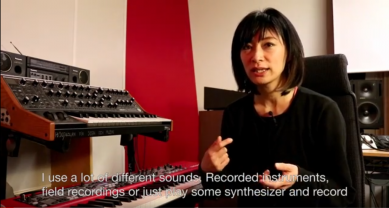
The Material Politics of Techno Punk
Experimental electronic producer Kyoka’s track «Toy Planet» is not overtly political. Yet, our author argues that the frenetic cutting techniques that Kyoka uses to arrange her sampled sound materials stand for what he calls «techno punk», an attitude that emerges at the re-contextualization of samples that reduces them to a pure sonic fabric devoid of semantics or extra-musical meaning. This technique is political inasmuch as it enables Kyoka to ambiguously position herself outside of the club music versus experimentation binary.
In «Toy Planet», a track from Kyoka’s 2014 album, Is (Is Superpowered), Kyoka assembles a variety of found and self-made sound materials into a track of experimental dance music. I refer to the technique used here as «sampling» instead of «recording» because once she has the sound materials as digital files at hand, she heavily processes, cuts, plays with, and rearranges them.1 The compositional process emerges from the sound material itself, rather than following a pre-made plan that then is recorded. The sound materials that she samples are extremely diverse. Some of them stem from inherently musical contexts, such as a portion of a drum groove from a found record, much reminiscent of African American underground styles such as Chicago house or early Bronx hip hop.
Yet, she also improvises with analog synthesizers and records real-world sounds in cities around the world. These rough materials only later acquire musical meaning, when Kyoka finds portions that she uses as loops in the new track. As Kyoka says, «I try to find some nice groove or rhythm from that [the field recordings]» (Ableton 2017, 00:25). She uses such portions as background tracks for vocal improvisation, which she similarly captures, and in the case of «Toy Planet», uses both as lead vocals as well as fragmented snippets, woven into the dense sonic fabric.
«Textural Sampling» in «Toy Planet»
If we understand «political» to mean that traces of the socio-cultural origin of a given sample are present, then neither the materials from which «Toy Planet» is assembled, nor the context of the track are inherently political. Traffic noises from a generic city, an analog synth oscillator recorded in an unspecified studio, sometimes not even by Kyoka proper; it is simply impossible to pin these sounds down and associate them with a particular place, community of practice, or political agenda.2
In «Toy Planet», after 1:33, we start hearing vocal snippets that are chopped up and appear as a repeating pattern with a lot of variation. The pacing of the cuts, the brevity of the snippets, and the pure amount and speed of slices that my ears encounter when listening are so high that not only do the socio-cultural traces of the sampled materials disappear, but the sound material itself dissolves. Soon after, these samples reduce slowly to one single pitch, and the resulting texture is purely rhythmic at around 3:00. Finally, after 3:45, the vocal snippets are even briefer, giving rise to a sound that is only loosely reminiscent of a human voice and which, therefore, in the words of Madrid-González (ibid.), «make[s] it impossible to recognize these sounds as markers of any particular ethnic identity, making [the track] more abstract». We are left with a texture of sound, in which the individual samples completely lose their original meaning.3
Kyoka’s music is fundamentally different from other sampling or synth-made dance music, which is why I call her technique «textural sampling» in contrast to what has been coined «glitch» or «granular».4 The essential difference is that Kyoka playfully blurs the line between her samples, temporal shaping of samples, editing artifacts, and musical functions. As a consequence, it is hard to distinguish between materials and techniques. Short bits of an undisclosed texture stand in for what would otherwise be hi-hat patterns. Abstract loops, aligned to a metric software grid, render the meter audible and render it bodily, that is, ultimately danceable. Not surprisingly, «Toy Planet’s» BPM (beats per minute) of 105 is a reference to a medium hip hop or slow dance track. At the end of «Toy Planet», after 4:42, the making of the low-end component of the track is revealed. The noisy bass or kick drum line, which perhaps in other club music would be of clearly synthetic nature, here is a sampled and heavily processed groove, enriched with noisy field recordings and artificial reverb.
The Material Politics of «Techno Punk»
Kyoka’s «textural sampling», although devoid of the «political» in the first place, clearly brings to the fore a «material politics» – by which I mean that there is a deep ambiguity in Kyoka’s work. Is she a sampling artist? Or is her music based on synthesis? Well, she is both to the same extent: even though she uses mostly sampling, the aesthetics of her sound is that of synthesis. In the words of Tara Rodgers, I call Kyoka’s music a «machine-produced veneer that always reflects back on human conditions, relations, desires», and so her music showcases «instances of the imploded and deeply interwoven categories of natural and cultural» (Rodgers 2015, 7).
This is what I call «techno punk», a punk aesthetics characterized by Kyoka assembling and destroying out-of-context materials, stripping them of their meaning, rendering them extremely dense collages and adding vocals in a more spoken than sung way. All of this occurs within the realm of, and is crafted with the means of, «techno» or «technology». The political of this «punk aesthetic», then, is manifest in Kyoka’s attitude, for she is departing from more «pure» electronic genres toward heavily ambiguous, distorted, skewed sonic DIY5 collages that are «fine» and «pointillistic» (Madrid-González 2008), «natural and cultural» (Rodgers 2015), and yet crude and dense. They are anti-establishment and anti-institutional as they evade the music industry’s standard classifications – it comes as no surprise that Kyoka is never categorized as a mainstream club music producer, nor is she sufficiently recognized in experimental music.6 Indeed, without being overtly political, Kyoka’s «Toy Planet» and her technique of «textural sampling» are covertly political, for they challenge listener expectations and value sets that are attached to the experimental or the popular music market. I read her «techno punk» as the subtle resistance of a conscious, self-designated outsider.

- 1. Two interviews with Kyoka on YouTube reveal some of her techniques and materials. One is a short interview conducted by the company Ableton with certainly a commercial agenda of product placement (Ableton 2017). The other is an institutional interview done by the Academy of Music and Drama in Gothenburg, Sweden (University Gothenburg 2017).
- 2. The same holds on the level of distribution, for «Toy Planet» is published by the prestigious Berlin-based electronica label, raster-noton, and is globally visible as a finished product, while also being performed by Kyoka in various clubs around the globe. These situations are mostly dance venues and venues for experimental electronic music; they will rarely exhibit any political agenda as their primary objective.
- 3. When I write that samples «completely lose their original meaning» then it is clear that while they lose the traces to the original context from which they stem, the process of sampling itself will always index the history of appropriation, as is discussed, among others, by Théberge 2004.
- 4. For a discussion of «glitch» as a musical genre, see Cascone 2000, but also, for a feminist critique thereof, Rodgers 2010. For a technical explanation of «granular synthesis» as a technique in electronic music, see Roads 1988.
- 5. DIY stands for «do it yourself», an expression that I use here to emphasize the peculiarity of Kyoka’s sampling techniques, which exist beyond the standard use of customary electronic music gear.
- 6. A blog poster, in an album review, writes, «This is a fun record, but not in the sense that it doesn’t take itself seriously as a valid musical statement away from the dance floor. There can be an introspective, earnest academic endeavor to the play involved in making music», and also, that «this album has that rare breed of crossover appeal that maintains ‹authenticity› to the underground kids, yet offers palatability to a wider audience beyond the clubs, the 5am dance parties, and the niche festivals» (Sheriffbart 2014).
List of References
This article is part of Norient’s online publication Sampling Politics Today, published in 2020 as part of the research project «Glocal Sounds – Re-Working and Re-Coding Place References» (No. 162797), funded by the Swiss National Science Foundation (SNSF) and supported by the Bern University of the Arts HKB.
Bibliographic Record: Zaes, Marcel. 2020. «The Material Politics of Techno Punk». In Sampling Politics Today, edited by Hannes Liechti, Thomas Burkhalter, and Philipp Rhensius (Norient Sound Series 1). Bern: Norient. DOI: 10.56513/nftg6449-19.
Biography
Published on September 24, 2020
Last updated on April 09, 2024
Topics
Sampling is political: about the use of chicken clucks or bomb sounds in current music.
Why does a Kenyan producer of the instrumental style EDM add vocals to his tracks? This topic is about HOW things are done, not WHAT.
From the political implications of human voice to its potential of un-making sense.
Special
Snap
